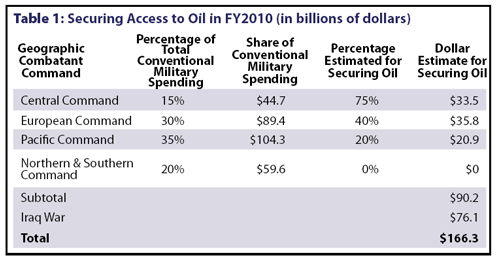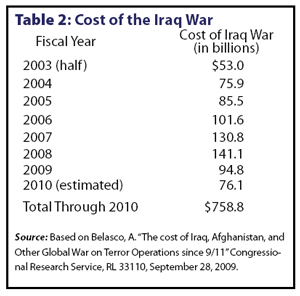This article is from the May/June 2010 issue of Dollars & Sense: Real World Economics, available at http://www.dollarsandsense.org

This article is from the May/June 2010 issue of Dollars & Sense magazine.
Subscribe Now
at a 30% discount.
The True Cost of Oil
What are the military costs of securing “our” oil?
When Americans pull up to the pump, the price they pay for a gallon of gas does not begin to reflect the true costs of extracting, transporting, and burning that gallon of fuel.
Most people know that burning fossil fuels contributes to climate change. Every time we drive our cars, we are sending greenhouse gases into the air, which trap radiation and warm the earth’s surface. The more the earth warms, the more costly the consequences.
But as bad as the costs of pollution and global warming are, as taxpayers we pay another cost for oil. Each year, our military devotes substantial resources to securing access to and safeguarding the transportation of oil and other energy sources. I estimate that we will pay $90 billion this year to secure oil. If spending on the Iraq War is included, the total rises to $166 billion.
This year, the U.S. government will spend $722 billion on the military, not including military assistance to other countries, space exploration, or veterans’ benefits. Defending American access to oil represents a modest share of U.S. militarism.
Calculating the numbers isn’t straightforward. Energy security, according to national security documents, is a vital national interest and has been incorporated into military objectives and strategies for more than half a century. But military documents do not attach a dollar figure to each mission, strategy, or objective, so figuring out which military actions relate to oil requires plowing through various documents and devising methodologies.
The U.S. military carves the world up into regions—Europe, Africa, the Pacific, the Middle East, South America and North America—each with its own command structure, called a “unified combatant command.” I arrived at my estimate of military spending related to securing oil by tracing U.S. military objectives and strategies through these geographic commands and their respective fleets, divisions, and other units. I only considered conventional spending, excluding spending on nuclear weapons, which is not directly related to securing access to resources.
U.S. Central Command has an “area of responsibility” which stretches from the Arabian Gulf region through Central Asia and was specifically created in 1980 during the Carter administration because of the region’s oil reserves. Two-thirds of the world’s oil reserves and nearly half of natural gas supplies reside within these twenty countries. Aside from joint training exercises with oil-producing nations, securing oil fields, and a host of other oil-related tasks, the command closely monitors the Strait of Hormuz. Nearly half of all oil transported throughout the world passes through this chokepoint, which has been periodically threatened with disruptions. I estimate about 15% of conventional military spending is directed at supporting the missions and strategies of Central Command, and three-quarters of that spending is related to securing and transporting oil from and through the region, as shown in Table 1.

U.S. Pacific Command ensures transportation of oil, specifically through the Strait of Malacca, one of the two most important strategic oil chokepoints. Fifteen million barrels of oil per day flow from the Middle East and West Africa to Asia. This oil is particularly important to another oil-dependent country—Japan, an important American ally in the region. Pacific Command is the largest of all the commands, covering half of the globe. It is also responsible for the largest number of troops and is an important provider of training and troops to U.S. Central Command. Given information on bases, assigned troops and other indicators, I estimate that about 35% of conventional military spending is required for missions and strategies for this command and about 20% of that amount is needed for securing the transport of energy throughout the region.
U.S. European Command and U.S. Africa Command also have resources devoted to securing access to energy. Initially formed to protect Western Europe against Soviet aggression, European Command is currently postured to project power toward the energy-rich areas of the Caspian Sea, the Caucasus, and the Middle East. Alongside NATO, European Command is increasingly focused on energy security in Europe, especially since the revision of NATO’s Strategic Concept in 1999. Finally, the command was also responsible for overseeing the set-up of the newest command, U.S. Africa Command, which was motivated by competition for newly discovered oil reserves. I estimate that around 25% of the military budget is devoted to military strategies relating to Europe and Africa, and of that, about two-fifths can be attributed to securing oil and energy supplies.
U.S. Northern Command and U.S. Southern Command are responsible for North and South America and the surrounding waters. While Canada, Mexico, and Venezuela rank in the top five countries from which the United States imports oil, I could not find definitive activities connected with either Northern or Southern Command that would justify inclusion in the estimate.
Dividing the military budget according to geographic regions and reviewing activities in those regions leads me to conclude that about $90 billion will be spent this year for securing access to and the transport of oil and other energy supplies.
But that number does not include the vast sums spent on the Iraq War. In spite of the Bush administration’s claims that the United States invaded Iraq because of weapons of mass destruction, evidence points to oil. Since World War II and historic meetings between President Roosevelt and the leader of Saudi Arabia, U.S. policy interests have been focused on establishing a stronghold in the region. Prior to the invasion, the Bush administration had already made plans for the oil industry, and currently, the military surrounds and secures the oil fields.
Since 2003, the Iraq War has cost U.S. taxpayers three-quarters of a trillion dollars, as shown in Table 2. Though spending will decline this year, including the Iraq War brings total spending on securing access to oil to $166 billion. Other analysts might point to the strategic importance of Afghanistan in a resource-rich region, but spending on that prolonged war and occupation is not included in this analysis.

Recently, President Obama appeased the oil industry by opening large parts of the East Coast, Gulf waters, and elsewhere to drilling. But this shortsighted policy would only lessen our dependence on foreign oil by a trivial amount. Moreover, if production were increased, oil prices may drop and the average American may choose to drive more. Bring back the Hummer.
Instead, the $166 billion that we are spending right now on the military could subsidize and expand public transport, weatherize homes, and fund research on renewable energy. Typically, the federal government invests only $2.3 billion in renewable energy and conservation each year. Even the stimulus bill, which contained an unprecedented amount of spending for renewable energy and conservation, pales in comparison with military spending. Stimulus spending included $18.5 billion for energy efficiency and renewable energy programs, $8 billion in federal loan guarantees for renewable-energy systems, and $17.4 billion for modernization programs such as the “smart” electricity grid, which will reduce electricity consumption. While these healthy federal investments—spent over several years—will encourage a move away from fossil fuels, strategic military operations securing access to those climate-changing resources will continue to dominate our taxpayer dollar.
Put all these numbers in perspective: The price of a barrel of oil consumed in the United States would have to increase by $23.40 to offset military resources expended to secure oil. That translates to an additional 56 cents for a gallon of gas, or three times the federal gas tax that funds road construction.
If $166 billion were spent on other priorities, the Boston public transportation system, the “T,” could have its operating expenses covered, with commuters riding for free. And there would still be money left over for another 100 public transport systems across the United States. Or, we could build and install nearly 50,000 wind turbines. Take your pick.
Did you find this article useful? Please consider supporting our work by donating or subscribing.
